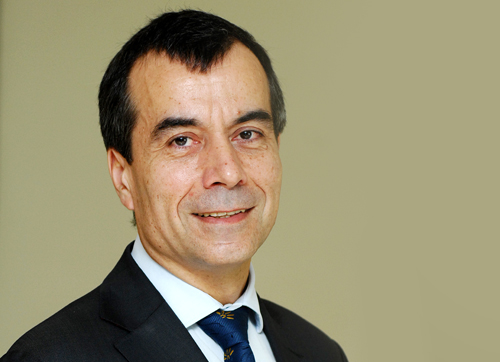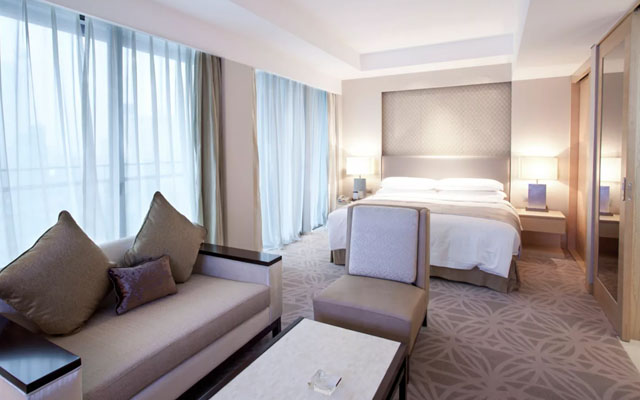The former CEO of Emaar Hospitality Group – whose hotels brands include The Address and Armani – is on a mission to make Coco the new resort address for owners and well-heeled clients.

Patrick Heuze, CEO, Sunland Hotels and Coco Collection Resorts
You’re about a month into your new role. Why the move from Emaar to Sunland?
It’s an opportunity to rejoin a group I had previously worked with for eight years, this time as CEO and equity partner in Coco Collection (a division of Sunland, an established family-owned company in the Maldives). Ultimately, a lot of people at my level will want to have their own business at one point or another, so this gives me the chance to start out.
So you’re a familiar face at Sunland after all.
Yes, I first came to the Maldives in 1997, opening the Hilton Rangali, then went to Japan with Hilton in Nagoya before returning to the Maldives and opened the Coco Palm Dhuni Kolhu (in 1998) and later, as group GM, overseeing Coco Palm Bodu Hithi (opened in 2006, see Luxury Travel, page 12).
Once we get these two properties, and a third – a small, exclusive five-villa island (near Coco Palm Bodu Hithi) which we are developing – on the right platform and confident we have the right product to showcase the brand, we can start expanding Coco outside the Maldives.
That will make Sunland the first homegrown Maldivian hotel company to venture out of its home base. Are you doing another Address?
(Laughs) Kind of, but only limited to resorts, boutiques and retreats, not cities.
What is your structure for the overseas expansion?
We’re establishing a registered company in Dubai, which will be the head office for Coco Collection, and the normal corporate structure is being established; we’re hiring a director of sales and marketing, HR, training and development, finance and I’ve already recruited a director of technical services.
While the core activity is currently concentrated in the Maldives, it is important we display our commitment that we want to be a regional or global brand by having a head office in Dubai or Singapore. We picked Dubai as I’m familiar with Dubai and it has more fiscal incentives than Singapore.
It is important we demonstrate to owners that we are putting in a professional structure for future development, that we are not a local Maldivian company only.
So how different is Coco to, say, One&Only?
If we were to draw any parallel between the two, I would say they (One&Only) are ‘luxurious’ luxury. We want to make it ‘simple’ luxury, ‘natural’ luxury, where people will really feel the beauty of the island or destination they are in, as well as the local experience and interaction.
One&Only (Reethi Rah, Maldives) is very beautiful but, for me, clinical. It is not ostentatious, but too luxurious vis a vis the experience one would expect when visiting the Maldives.
Which resort brand do you admire the most?
I admire Six Senses for its environmental leadership, Amanresorts for its simple but exclusive luxury, and W Hotels for its design, even if it’s a little too minimalistic. So it’s a combination of the three and we have to create our own identity, not copy or align ourselves with any of those concepts.
What does it take to create a brand like The Address or Armani and what lessons might there be from your experiences there for Coco?
When we developed The Address, we did not try to copy anyone but looked at what our customers would be tempted to patronise. We all came from different origins; there were people from Hyatt, Ritz-Carlton, Hiton, etc, and the last thing we wanted to do was to recreate something we had been working with in the past, but to take the best practices of these companies. So the service of Ritz-Carlton – but we didn’t want anything too traditional. Or the design of W – but we didn’t want something overly-designed without warmth.
The Address has a residential feel and that is also through how our associates engage the guests – we set the standards but give them the freedom to interact with guests, so that the guest, and not policies and procedures, becomes the priority. As well, the F&B concepts became the talking point in Dubai and helped position the brand.
“It is important we demonstrate to owners that we are putting in a professional structure…”
What does Coco Palm Bodu Hithi, already a superb product, need in order for it to be the launchpad of the brand to the world?
We need to bring more life to the resort. We need to bring in an interior designer to give us some new ideas to uplift the product. It is good, but there is room for improvement, especially when I’ll be using it as the showcase to owners. So we’ll be spending some US$2-US$4 million to upgrade the product this year.
What do luxury resort travellers today want?
Customers are looking for value and a different form of holiday, one which provides an experience, not where they will only return with a sun tan. They want a relaxing holiday, not in the sense of being pampered, rather, engaging and hassle-free.
Having played a big role in development at Emaar, what gap do you think Coco can fill for owners?
What I’ve seen is that new owners or developers are a bit tired of the big brands.
They feel they are a small fish in a big pond. With small operators like us, they are a big fish in a small pond. They feel the rapport and relationship, there is better chemistry, and they are more comfortable. In my previous employment as CEO, I would go and communicate with developers and owners to show that I was really interested in getting their business, while the established chains would send someone else.
So the owners feel they are not given the importance they deserve. They feel as well that the big chains are only keen on signing management agreements but not servicing them, and that they are not interested in small units. They want critical mass, 250 or 300 plus rooms, while operators like us, or even Emaar, are willing to take on small resorts of 50, 60, 80 rooms which might not be as profitable as the larger units but give us the opportunity to grow and wave our flags in different cities or secondary cities.
So your target will be small resorts and there’s plenty in this part of the world?
Yes, plenty, plenty. I would say 50 to 150 rooms. And I don’t have the ambition to be a global company. I think there is a lot to be done in this part of the world, which has gone through the economic crisis but is still thriving with not just foreign tourists but its own domestic population. Take Indonesia, for example, where there is limited hospitality infrastructure for the locals. Or untapped markets like Vietnam, Cambodia or Myanmar, which represent opportunities for us.
There are opportunities as well in North Africa, like Morocco, but I don’t want to overspread ourselves because I want to be able to service our customers. So I don’t want to go to North America or the Caribbean or West Africa. Geographically we should limit ourselves to a particular region and I think that region stretches from East Africa to Indonesia.
Where do you think the first Coco property outside the Maldives will be?
I am negotiating something for 2013 in Indonesia. Lombok, for example, is an emerging destination. Bali is a bit saturated.
This article was first published in TTG Asia, January 27 issue, on page 6. To read more, please view our digital edition or click here to subscribe.




















